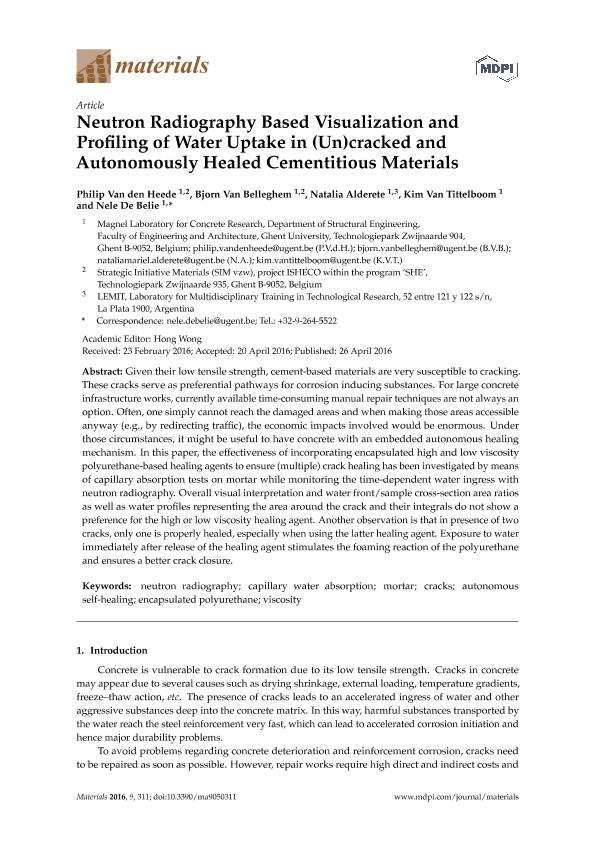Artículo
Neutron radiography based visualization and profiling of water uptake in (Un)cracked and autonomously healed cementitious materials
Van den Heede, Philip; Van Belleghem, Bjorn; Alderete, Natalia Mariel ; Van Tittelboom, Kim; de Belie, Nele
; Van Tittelboom, Kim; de Belie, Nele
 ; Van Tittelboom, Kim; de Belie, Nele
; Van Tittelboom, Kim; de Belie, Nele
Fecha de publicación:
04/2016
Editorial:
Multidisciplinary Digital Publishing Institute
Revista:
Materials
ISSN:
1996-1944
Idioma:
Inglés
Tipo de recurso:
Artículo publicado
Clasificación temática:
Resumen
Given their low tensile strength, cement-based materials are very susceptible to cracking. These cracks serve as preferential pathways for corrosion inducing substances. For large concrete infrastructure works, currently available time-consuming manual repair techniques are not always an option. Often, one simply cannot reach the damaged areas and when making those areas accessible anyway (e.g., by redirecting traffic), the economic impacts involved would be enormous. Under those circumstances, it might be useful to have concrete with an embedded autonomous healing mechanism. In this paper, the effectiveness of incorporating encapsulated high and low viscosity polyurethane-based healing agents to ensure (multiple) crack healing has been investigated by means of capillary absorption tests on mortar while monitoring the time-dependent water ingress with neutron radiography. Overall visual interpretation and water front/sample cross-section area ratios as well as water profiles representing the area around the crack and their integrals do not show a preference for the high or low viscosity healing agent. Another observation is that in presence of two cracks, only one is properly healed, especially when using the latter healing agent. Exposure to water immediately after release of the healing agent stimulates the foaming reaction of the polyurethane and ensures a better crack closure.
Archivos asociados
Licencia
Identificadores
Colecciones
Articulos(CCT - LA PLATA)
Articulos de CTRO.CIENTIFICO TECNOL.CONICET - LA PLATA
Articulos de CTRO.CIENTIFICO TECNOL.CONICET - LA PLATA
Citación
Van den Heede, Philip; Van Belleghem, Bjorn; Alderete, Natalia Mariel; Van Tittelboom, Kim; de Belie, Nele; Neutron radiography based visualization and profiling of water uptake in (Un)cracked and autonomously healed cementitious materials; Multidisciplinary Digital Publishing Institute; Materials; 9; 4-2016; 311-339
Compartir
Altmétricas



